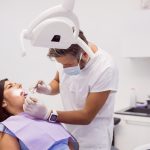1. I’m Too Old for Braces
There is no age limit for having braces. For the longest time people have believed that braces are only for teenagers and young adults. However, you can get braces at any age.
You can get braces for cosmetic reasons, to correct misalignments, to manage pain in the jaw joint or to reposition teeth for teeth replacement treatment.
However, it is important to note that orthodontic treatment generally takes a shorter time in teens and young adults. This is because their bones are still developing. Therefore, teeth movement is easy in their case. Jawbone growth stops at around 20 years.
Orthodontists have been trained to move teeth even after bone growth has stopped so this is nothing to be concerned about. The duration of treatment varies from patient to patient depending on the case.
2. I Can Make My Braces at Home
You can find literally anything on the internet. If you are considering orthodontic treatment, chances are that you’ve gone through web pages and found posts on DIY braces.
There are numerous videos on social applications on how to make them and people sharing the results they’ve achieved. They promise you quick, effective and affordable tooth straightening treatment.
So what are DIY braces? DIY( Do It Yourself) braces are home-made ‘braces’ made from either rubber bands, office clips, glue, earrings; all manner of things. It is total chaos and extremely dangerous! Do not try any of these hacks. Here are reasons why:
* You can get infections. The equipment and materials used are not sterile; the pathogens on them can lead to serious infections
* Some products used, such as glue, are toxic to our bodies
* It can lead to tooth loss. The rubber bands can get into the gums and cause root resorption. This makes the teeth loose in its socket and eventually fall off
* You can create more orthodontic problems rather than solve them. You will be adjusting bones with no guide and certainly no professional supervision. There is a reason orthodontists go for training on moving teeth!
* Your gums and jawbone will suffer because you will very likely move your teeth too fast. You may get periodontal diseases because of the strain put on the structures supporting the teeth
DIY braces bring more harm than good and you should not attempt to use them. They may cost you more than what you would pay at the orthodontic clinic.Rather than go the DIY braces route, consider negotiating a payment plan with your dentist. Trust the professionals to correct your misalignment.
3. Braces Are Just for Cosmetic Purposes
Not only do braces fix your smile but also treat and prevent other dental problems. Misalignment can put a strain on the facial muscles when the teeth are in use. This strain causes pain. The pain can be managed by painkillers but can only be resolved after alignment treatment.
Crowded teeth can pose a challenge to teeth cleaning. Plaque accumulates on the teeth and can lead to tooth decay and gum disease.
Poor teeth alignment can also cause issues in speech development. Teeth are important in producing some sounds. Fixing the misalignment and speech therapy can improve your speech.
4. Traditional Braces Are My Only Option
Traditional braces use metal wire and brackets to straighten teeth. For most adults, having grey brackets and wires on their teeth is not all that exciting. They refrain from getting orthodontic treatment because they don’t like the grey colour.
But their beliefs are misguided. Here’s why.
There are different types of braces;
* Traditional braces. They use metal wires and brackets. They are the most widely used teeth straightening option. Traditional braces are effective in treating complex misalignment cases
* Ceramic braces. The brackets of these braces are made of ceramic and the wires have an off-white colour. You can choose to either have clear brackets or those that match the colour of your teeth. It’s very difficult to spot from a distance and you don’t have to worry about having the grey colour of traditional braces.
* Lingual braces. They are like traditional braces but are cemented onto the back of teeth instead of the front. This means that they are hidden behind the teeth and only very keen people can see them. They use smaller and smoother brackets to prevent irritation of the tongue and gums.
Apart from braces, there are other methods of managing misalignment such as the use of clear aligners, veneers and crowns. The choice of the treatment method depends on the complexity of the case, your finances and what you desire.
5. Any Dentist Can Correct Teeth Misalignment
Not all dentists can correct your misalignment. Dentists have to undergo specialized training to become orthodontists. Orthodontists prevent, diagnose,and correct teeth misalignment and jaw irregularities. Moving teeth can be a complicated procedure since it involves reconstructing the anatomy of the jaw. Therefore, you should visit an orthodontist if you have a teeth misalignment problem.
If you suspect you have a teeth misalignment problem, book an appointment with us today. We are always happy to help.















